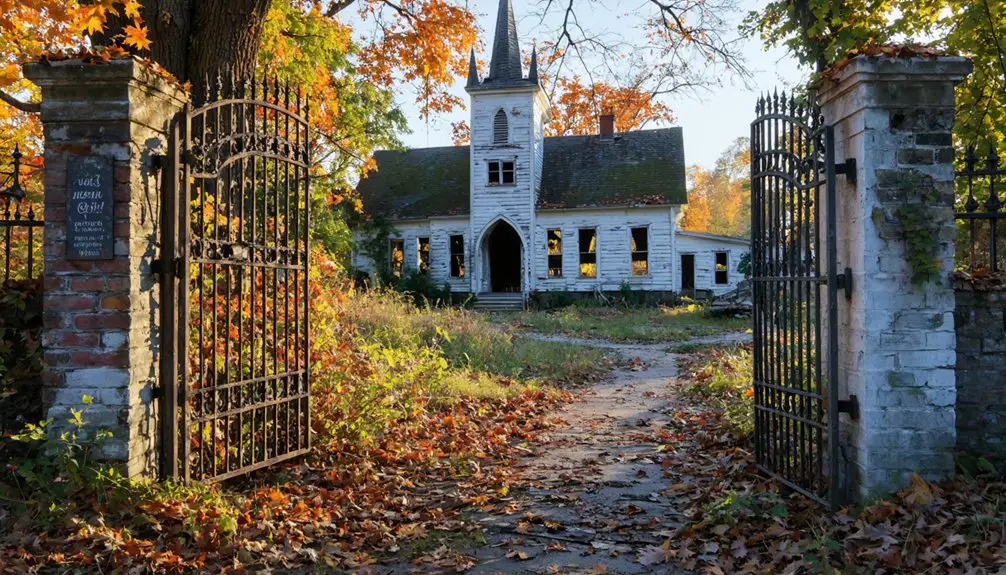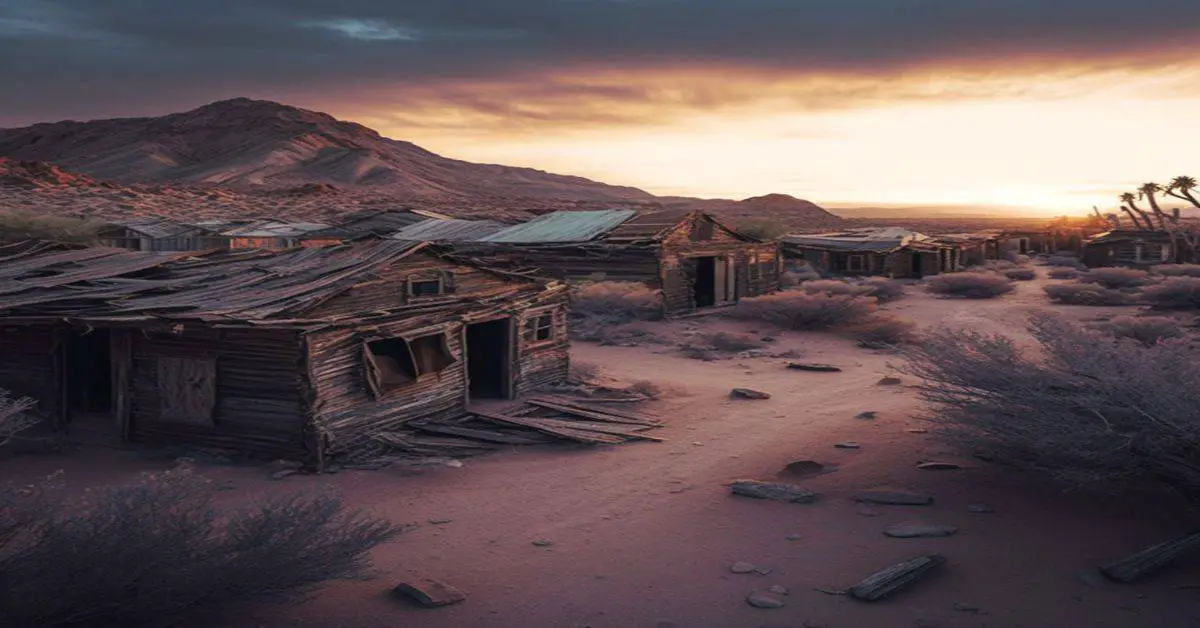You’ll find Jayville’s ghost town ruins in northern New York, where iron ore mining operations thrived from 1854 to the early 1900s. The town developed around high-grade magnetite deposits, with ore grades reaching 60%. While the arrival of the Carthage and Adirondack Railroad in 1887 briefly boosted the economy, flooding and litigation eventually led to its abandonment. Today, water-filled pits and scattered remnants tell a compelling story of industrial ambition and decline in the Adirondacks.
Key Takeaways
- Jayville was a 19th-century iron mining town in northern New York that operated from 1854 until its decline in the 1890s.
- The town’s mines produced high-grade magnetite and vonsenite ores with iron grades of 40-60% before flooding issues caused abandonment.
- The arrival of Carthage and Adirondack Railroad in 1887 briefly boosted the economy before mining operations became commercially unviable.
- Today, Jayville is accessible via Jayville Road, featuring water-filled mine pits and remnants of railroad infrastructure amid forest reclamation.
- Multiple failed revival attempts, including during World War I and 1941, ultimately led to Jayville’s complete abandonment as a ghost town.
The Birth of a Mining Community (1850-1854)
While geological surveys in northern New York had identified promising iron deposits throughout the 1830s and 1840s, Jayville’s mining operations didn’t begin until 1854 under Zebulon H. Benton. Early mining efforts revealed magnetite and vonsenite ores grading between 40-60% iron, though initial extraction proved challenging due to the site’s isolation.
You’ll find the community’s formation was deeply intertwined with these mining beginnings. Workers hauled ore by wagon approximately 15 miles to Fullerville’s blast furnaces, as no railroad yet served the area.
Mining took place on both eastern and western hill flanks, but the ore wasn’t abundant enough for profitable large-scale operations. The settlement’s development reflected the frontier spirit of resource exploitation, despite primitive infrastructure and transportation limitations.
Railroad Development and Economic Growth
Though Jayville’s early mining ventures struggled with isolation, the arrival of the Carthage and Adirondack Railroad in 1887 transformed the town’s economic landscape.
You’ll find that rail transport revolutionized the region’s industrial capabilities, connecting Jayville to essential markets and processing centers. Similar to earlier lines that had supplemented canal travel, these railway connections opened up new transportation possibilities.
The railroad’s extension to Benson Mines in 1889 proved important for mining operations, allowing efficient movement of iron ore and necessary supplies.
This regional connectivity wasn’t new to the area – the Black River and St. Lawrence Railroad had attempted a 38-mile track to Jayville as early as 1869, setting the stage for future development. Similar to other regional railways like the Lowville & Beaver River, these rail connections were vital for supporting local industries and communities.
Mining Operations and Industrial Heritage
Since its inception in 1854, Jayville’s mining operations centered on extracting high-grade magnetite and vonsenite minerals, with ore grades reaching up to 60% iron content.
You’ll find that early mining techniques involved hauling ore by wagon to Fullerville’s blast furnaces, until the Carthage and Adirondack Railroad‘s completion in 1886 revolutionized transport efficiency.
The community’s resilience showed through various operational phases, from the Magnetic Iron Ore Company’s development in the 1880s to Jones and Laughlin Steel Corporation‘s modernized operations during the World Wars. The town’s dark history includes incidents where workers were tarred and feathered by locals for perceived wrongdoings.
Despite technological advancements and the construction of a significant ore processing mill in 1941, Jayville’s mines struggled with water infiltration and inconsistent ore quality.
These challenges ultimately led to the site’s decline, though its industrial heritage lives on through historical documentation and its influence on regional mining development.
The Decline and Abandonment
You’ll find that Jayville’s economic decline stemmed from multiple industrial challenges, including persistent mine flooding that thwarted reopening attempts in 1914 and during World War I.
The steel industry’s advancement and changing market demands reduced the need for local ore, while legal battles over mineral rights and railroad tariffs in 1892 further crippled mining operations. Established by Z.H. Benton in 1854, the town initially showed promise with its iron ore operations. Like many ghost towns, Jayville now provides historians with valuable insights into past mining operations and economic activities.
Despite temporary support from sawmill industries in the 1890s, Jones & Laughlin Steel Corp’s 1941 assessment deemed the ore deposits commercially unviable, effectively ending all major mining activity in the area.
Economic Factors Behind Failure
The once-thriving mining town of Jayville faced a devastating economic decline in the 1890s when costly litigation over mineral rights and railroad tariffs paralyzed its primary industry.
You’ll find that these litigation challenges created insurmountable financial burdens, driving away potential investors and leading to severe economic stagnation.
When mining operations ceased, the town attempted to pivot to sawmills and railroad industries, but these proved insufficient for long-term sustainability. Like many small towns disappearing across New York State today, Jayville’s population dwindled as economic opportunities vanished.
The situation worsened as flooded mines resisted reopening attempts, with pumping costs exceeding any potential profits.
Technological advances in steel production elsewhere made Jayville’s ore increasingly obsolete, while larger, more efficient mining operations outcompeted the town’s smaller-scale operations.
These combined factors ultimately sealed Jayville’s fate, driving its population to more viable mining locations.
Mining Operations End Permanently
After decades of intermittent mining operations, Jayville’s mines permanently closed in 1941 when Jones & Laughlin Steel Corporation deemed the remaining ore body commercially unviable.
You’ll find that mining technology and infrastructure limitations played significant roles in the town’s demise.
While mining had begun in 1854 under Zebulon H. Benton, operations struggled due to inadequate transportation and inefficient ore processing methods.
The completion of the Carthage and Adirondack Railroad in 1887 came too late to save the struggling mines.
During World War I, attempts to revive operations failed when mine flooding overwhelmed available pumping systems.
Despite several assessments of the site’s potential, the combination of challenging terrain, insufficient ore quality, and technological constraints guaranteed that no commercial mining would ever resume after 1941.
What Remains Today: A Ghost Town’s Legacy

Today, remnants of Jayville stand as silent witnesses to its industrial past, with only the abandoned railroad station on New York State-owned land southeast of Harrisville marking its former existence.
A ghost town’s lonely station echoes its industrial heritage, the last sentinel of Jayville’s bygone era.
You’ll find few architectural remnants beyond this weathered structure, as nature has reclaimed most of the former hamlet. The landscape bears subtle scars from its mining era, with water-filled pits and traces of the Carthage and Adirondack Railroad infrastructure still visible.
While you can access the site via Jayville Road, you won’t find developed tourist facilities or maintained trails. The site’s abandonment was primarily caused by mine flooding issues that made continued operations impossible.
Instead, you’ll discover a place where natural reclamation has transformed industrial ruins into wildlife habitat, and where former sawmill sites and mining operations are now merely whispers in the forest’s understory.
Historical Impact on New York’s Industrial Landscape
Founded in 1854, Jayville emerged as a significant contributor to New York’s industrial expansion through its iron ore mining operations and strategic position along the Carthage and Adirondack Railroad.
You’ll find evidence of industrial innovation in the town’s diverse operations, from iron smelting furnaces to brick kilns and sawmills that shaped regional manufacturing.
While the Magnetic Iron Ore Company’s mining ventures proved limited, Jayville demonstrated remarkable community resilience by adapting to changing economic conditions. Today, only remnants of mining and scattered ruins hint at the town’s once-bustling past.
The town’s rail junction became essential for timber transport after mining declined, maintaining its relevance in upstate New York’s industrial network.
Though multiple attempts at reviving mining operations failed, including efforts during World War I and a 1941 exploration by Jones & Laughlin Steel Corporation, Jayville’s legacy exemplifies the dynamic nature of 19th-century industrial development.
Frequently Asked Questions
Are There Any Reported Ghost Sightings or Paranormal Activities in Jayville?
You won’t find documented ghost encounters or haunted locations in this empty mining town, despite what you’re hoping for. The town’s abandonment stems purely from economic decline, not supernatural causes.
What Happened to the Families Who Lived in Jayville After Abandonment?
You’ll find family stories reveal residents scattered across St. Lawrence County, following predictable migration patterns to nearby towns where they found work in logging, farming, and factories after mining operations ceased.
Can Visitors Legally Explore the Jayville Site Today?
While the winds of freedom beckon, you’ll find uncertain legal access to state-owned Jayville. Without explicit visitor guidelines, you can reach the site, but must respect state property laws and safety concerns.
Were There Any Notable Crimes or Accidents During Jayville’s Active Years?
You’ll find only one notable incident in historical crimes: the 1895 tar-and-feathering of Mrs. Hattie Covey for adultery. Mining floods and a devastating fire marked the town’s industrial accidents.
Did Any Other Industries Besides Mining Exist in Jayville?
You’ll find several industries thrived alongside mining: sawmills dominated the timber industry, railroads maintained significant traffic, brick kilns operated steadily, and local merchants supported the town’s basic commercial needs.
References
- https://hudsonvalleypost.com/new-york-state-is-home-to-nearly-20-ghost-towns/
- https://raregoldnuggets.com/?p=4328
- https://www.thetravel.com/deserted-towns-in-new-york-state/
- https://en.wikipedia.org/wiki/Jayville
- https://lite987.com/11-ghost-towns-new-york-state/
- https://www.nysga-online.org/wp-content/uploads/2019/06/NYSGA-2014-B6-History-and-Geology-Review-of-Magnetic-Iron-Mining-in-the-Western-Adirondacks.pdf
- https://www.mininghistoryassociation.org/Journal/MHJ-v26-2019-Davison.pdf
- https://slcha.org/wp-content/uploads/quarterly/SLCHA_Quarterly_v054_no4.pdf
- https://www.wgpfoundation.org/historic-markers/early-mining-in-ny/
- https://www.american-rails.com/lowville.html



